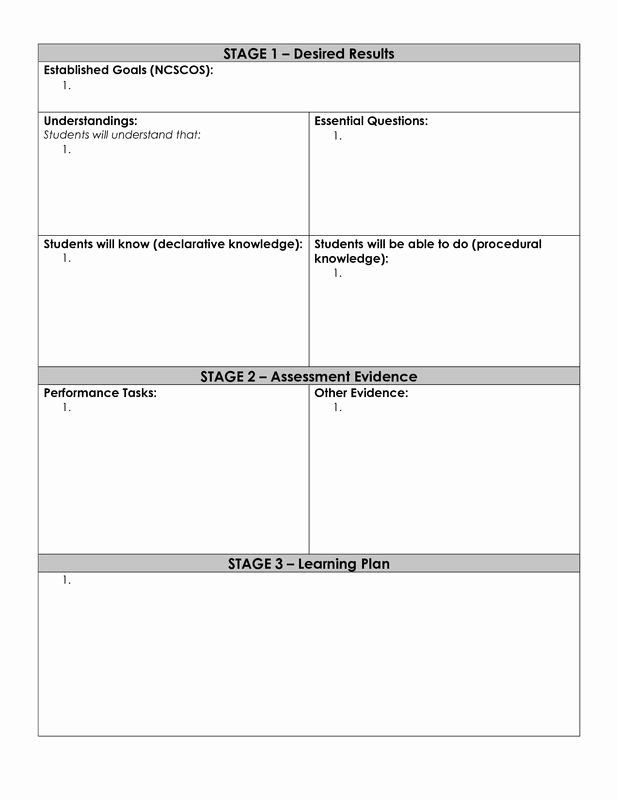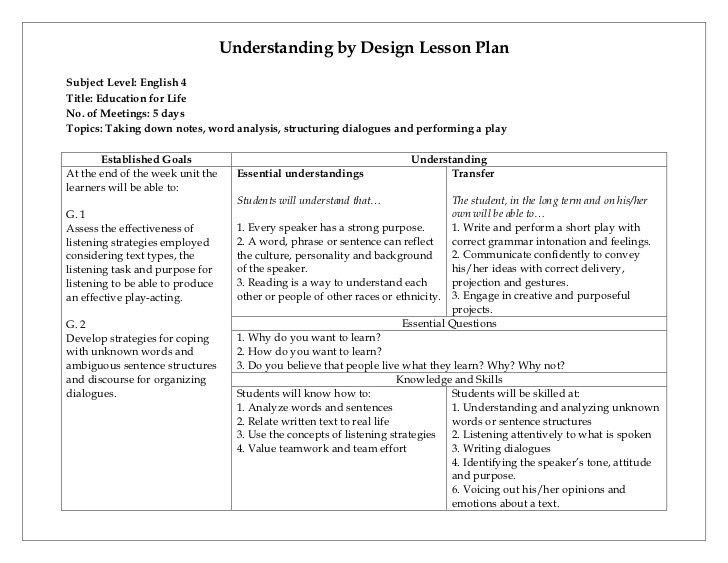Table Of Content

Multiple choice and short response questions are good formative assessments, but something bigger is called for as the main summative assessment if you want to measure your targeted goals. In the normal course of lesson planning most teachers plan “forward” by choosing specific content, learning standard or activity they want to accomplish and craft their lesson to fulfill that criteria. I hope this post helped answer your questions about the backward design approach and inspires you to give it a go in your classroom.
Backward lesson planning: Wrapped up
There is not a set number of recommended goals to write for this step. You’ll probably have somewhere in the range of three to seven learning goals for the course you are designing. There are lots of advantages to using backward design for your lesson plans. For starters, it ensures that your students will never be flabbergasted or taken by surprise by testing materials. They will never sit for a test and not know what the test is talking about or what he wants them to do.
Leadership Initiative for Language Learning (LILL)
Go through the independent activities included in your book as well, problem sets or the math boxes or any other independent work or exit tickets that the students might be doing or working on. When we look through all the elements of the unit at first, everything seems kind of blurry, out of focus and overwhelming. Once we focus on the standard, we can see traces of it in all the activities and we can see how it’s presented to students throughout the unit – assessment, independent practice, etc. However, as we know, delivering of the curriculum (the standards) doesn’t always mean that children will retain concepts to the application level or develop any depth of understanding.
Getting Started (and Mastering) Backward Design Lesson Plans
By defining what students should know or be able to do by the end of a lesson, educators can offer a more targeted and effective learning experience. Knowing the end goals allows teachers to craft learning experiences that offer just the right level of challenge and support, enabling students to work in their Zone of Proximal Development and thus optimize their learning. When students are aware of the learning objectives from the start, as they are in a Backward Design framework, they are likely to be more motivated to achieve those objectives. Knowing what the end goal is, just like knowing what the treasure is at the end of a hunt, can make the educational journey more motivating and fulfilling. In a classroom influenced by Constructivist principles, students are actively engaged, asking questions, and building their own understanding.

Student learning and understanding can be gauged more accurately through a backward design approach since it leverages what students will need to know and understand during the design process in order to progress. Think explicitly about how to organize your content logically given your course subject matter. Possibilities include sequencing it chronologically, around key themes, from simple to complex disciplinary skills, from theory to application, and so on. This is the material you present alongside your main course content to support students with the necessary disciplinary knowledge or foundational skills that underpin or relate to it.
“Aligning teaching for constructive learning.” Higher Education Academy Discussion Paper. The rigidity of the Backward Design framework has also been critiqued by educators like Sir Ken Robinson, who champion the benefits of creativity and freedom in educational settings. However, proponents argue that the time investment upfront often leads to more effective and efficient teaching down the line. Finally, the Zone of Proximal Development, a concept introduced by Russian psychologist Lev Vygotsky in the early 20th century, also supports the effectiveness of Backward Design. According to Vygotsky, this "zone" is the gap between what learners can do independently and what they can achieve with guidance. This teaching guide is licensed under a Creative Commons Attribution-NonCommercial 4.0 International License.
Understanding How to Use Backward Design in Your Lesson Planning
The right backward design lesson plan may result in a better learning experience for a classroom full of students, a private client, and everyone in between. We’re going to break down what backward design lesson planning is and why you should use it. The backward design approach to curriculum development first establishes educational goals and then builds assessment and instruction to serve those goals. The process of planning assignments and lessons by instructors to achieve pre-set instructional goals is called backwards mapping.
That way I can see at a glance if everything is checked off in the first two columns. For the Scientific Revolution unit students needed to analyze documents and figure out the point of view. They also are supposed to improve their essay writing skills, and form conclusions based on research. My dad, a carpenter, always used to say that any job was easy if you had the right tools. When sitting down to chart out your unit plan and a map of your lessons it’s useful to have a few tools of the trade handy. Another term often used for this process is Understanding By Design, a book written by Grant Wiggins and Jay McTighe.
Against Field Day: Experiential Education Shouldn't be a One Day Event (Opinion) - Education Week
Against Field Day: Experiential Education Shouldn't be a One Day Event (Opinion).
Posted: Tue, 21 Jun 2016 07:00:00 GMT [source]
Traditional Lesson Planning Vs. Backward Design
A well-designed rubric can help you align your assessments to your intended learning outcomes. Looking ahead to step two of backward design, you will need to identify evidence that an intended learning outcome has been obtained. If a learning outcome is not measurable, then we will not be able to know whether or not our course successfully achieved its goals.
“Backward Design” is an approach to creating curriculum, subjects, and even single class sessions that treats the goal of teaching as not merely “covering” a certain amount of content, but also facilitating student learning. Backward design prioritizes the intended learning outcomes instead of topics to be covered. (Wiggins and McTighe, 2005) It is thus “backward” from traditional design because instead of starting with the content to be covered, the textbook to be used, or even the test to be passed, you begin with the goals. Backward design in a lesson plan means starting with the end objective, such as student-focused learning goals, and designing your assessments and learning materials afterward to ensure your students achieve those objectives. But in other cases, it might be wiser to use backward design lesson plans.
Now that you’ve identified the outcomes and competencies for the course, repeat the process for the next modules/chapters in your course. Rinse and repeat and then go back to the beginning to review and have someone else to employ a fresh lens and perspective and check that its accurate.
Or you might keep them for other reasons—not every minute of class time has to be spent on standards-based instruction. Some activities have value because they help us get to know each other better, they help students develop social-emotional skills, or they simply offer a bit of fun. But if a lesson doesn’t do any of these things, if it’s disguised as learning but is doing little more than keeping students busy, it’s time for it to go. At this point, you have determined what students will know and be able to do by the end of your course.
Unlike content-oriented approaches, the backward design process begins by determining learning goals and outcomes for students. You then develop assignments that will help students practice and meet those outcomes. Decisions about course content and teaching strategies appear last, guided by reflection on what students will need to demonstrate their learning.
Your answers to those questions will become the backbone of your summative assessment. In the second stage of backward design, instructors create the assessments students will complete in order to demonstrate evidence of learning and even progress towards achievement of the learning objectives. (26 PD Hours) In this course, participants will learn the importance of and how to align your instructional strategies and activities with your learning objectives and plans for assessments.

No comments:
Post a Comment